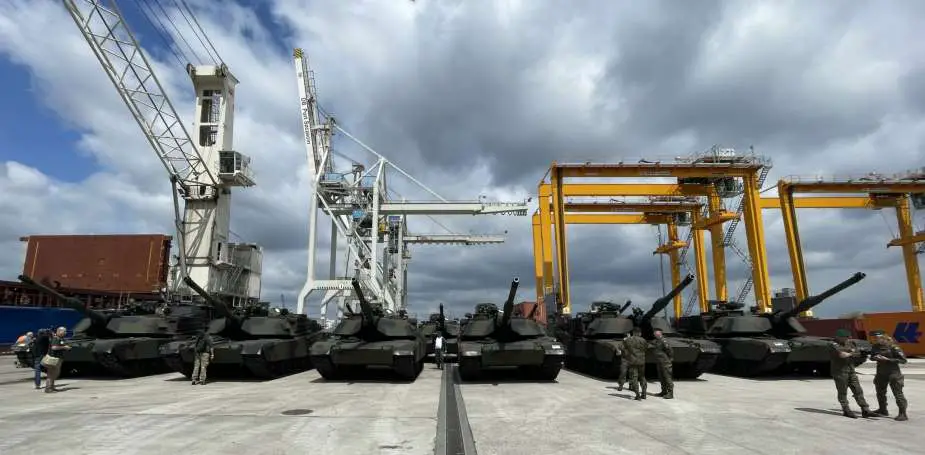Breaking news
Ukraine war fuels surge in US weapons exports: 2023 sets new sales records.
US weapons sales overseas rose sharply last year, Max Matza reports on BBC News, reaching a record total of $238bn (£187bn), as Russia's invasion of Ukraine stoked demand. The US government directly negotiated $81bn in sales, a 56% increase from 2022. The rest were direct sales by US defense companies to foreign nations.
Follow Army Recognition on Google News at this link

A shipment of 14 M1A1 Abrams tanks destined for the Polish army unloaded in the northwestern Polish port of Szczecin (Picture source: Twitter account of Polish Ministry of Defence)
In 2023, the United States experienced a remarkable upswing in its arms exports to international markets, setting a new record high. This surge in foreign military sales can be primarily attributed to the ongoing conflict in Ukraine, which has created an increased demand for advanced weaponry among several nations involved in the global defense and security landscape.
The Ukraine war, which originated in 2014 with the Russian invasion of Crimea, has continually evolved and escalated over the years. As a consequence, nations in Eastern Europe, as well as certain Western allies, have been keen on bolstering their military capabilities to ensure their security and act as a deterrent against potential aggressors. The United States, being a prominent global arms supplier, has seized the opportunity presented by this heightened demand, resulting in a significant boost in exports from its defense industry.
Several key factors have contributed to the record-breaking arms sales figures witnessed in 2023:
• Firstly, the increased demand for military equipment has been driven by countries close to Ukraine and those deeply concerned about the ramifications of the conflict. This surge in demand has encompassed a wide range of defense assets, including tanks, armored vehicles, missile systems, and small arms.
• Secondly, U.S. foreign policy has played a pivotal role in encouraging international support for Ukraine and its allies. The provision of military aid by the U.S. government, coupled with its efforts to persuade other nations to do the same, has further intensified the demand for American-made weaponry, aligning with U.S. strategic interests in the region.
• Additionally, the United States' reputation for advanced defense technology has been a significant driving force behind the surge in arms sales. This includes sophisticated missile defense systems, drones, and advanced communication equipment, all of which have been highly sought after by nations seeking to modernize their armed forces.
• Collaborative efforts between American defense companies and international partners have also streamlined the process of fulfilling orders, ensuring prompt and efficient delivery of high-quality weapons systems.
• Lastly, the U.S. government's export control policy has played a crucial role in maintaining the integrity of arms sales, ensuring that the weaponry reaches responsible hands and doesn't pose a risk to global stability.
While the spike in U.S. arms sales is undoubtedly a consequence of the Ukraine war, it raises significant questions about the long-term implications of such transactions. Concerns regarding arms proliferation, regional stability, and unintended consequences continue to be pertinent topics in international discussions and diplomacy.
As the Ukraine conflict continues to evolve, the dynamics of global arms sales will remain a topic of significant interest, both for those directly involved in the defense industry and for those closely monitoring the ever-changing geopolitical landscape.
Somehow in connection with the Russian aggressive attitude, Poland bought AH-64 Apache helicopters for $12bn, and also paid $10bn for M142 High Mobility Artillery Rocket Systems (HIMARS) and $3.75bn for M1A1 Abrams tanks, the Department said in a report for the US government's fiscal year that ended in October. It also spent $4bn on Integrated Air and Missile Defence Battle Command Systems.
Outside of Europe, the weapons report showed that South Korea paid $5bn for F-35 jets and Australia spent $6.3bn on C130J-30 Super Hercules. Japan reached a $1bn deal for an E-2D Hawkeye surveillance plane.
Defense News January 2024



















